Balkan Mountains
| Balkan Mountains | |
|---|---|
| Stara Planina, Стара планина | |
 A view from Kom Peak in western Bulgaria. | |
| Highest point | |
| Peak | Botev Peak |
| Elevation | 2,376 m (7,795 ft) |
| Coordinates | 42°43′00″N 24°55′04″E / 42.71667°N 24.91778°E |
| Dimensions | |
| Length | 530 km (330 mi) west-east |
| Width | 15–50 kilometres (9–31 mi) north-south |
| Area | 11,596 km2 (4,477 sq mi) |
| Geography | |
 | |
| Countries | Bulgaria and Serbia |
| Range coordinates | 43°15′N 25°00′E / 43.25°N 25°ECoordinates: 43°15′N 25°00′E / 43.25°N 25°E |
| Geology | |
| Type of rock | granite, gneiss, limestone |
The Balkan mountain range (Bulgarian and Serbian Cyrillic: Стара планина, Latin Serbian Stara planina, "Old Mountain"; Bulgarian pronunciation: [ˈstarɐ pɫɐniˈna]; Serbian pronunciation: [stâːraː planǐna])[1] is a mountain range in the eastern part of the Balkan Peninsula. The Balkan range runs 560 km from the Vrashka Chuka Peak on the border between Bulgaria and Serbia eastward through central Bulgaria to Cape Emine on the Black Sea. The highest peaks of the Balkan Mountains are in central Bulgaria. The highest peak is Botev at 2,376 m, which makes the mountain range the third highest in the country, after Rila and Pirin. The mountains are the source of the name of the Balkan Peninsula.
The mountain range forms the watershed between the Black Sea and Aegean Sea catchment areas, with the exception of an area in west, where it is crossed by the spectacular Iskar Gorge. The karst relief determines the large number of caves, including Magura, featuring the most important and extended European post-Palaeolithic cave painting, Ledenika, Saeva dupka, Bacho Kiro, etc. The most notable rock formation are the Belogradchik Rocks in the west.
There are several important protected areas: Central Balkan National Park, Vrachanski Balkan Nature Park, Bulgarka Nature Park and Sinite Kamani Nature Park, as well as a number of nature reserves. The Balkan Mountains are remarkable for their flora and fauna. Edelweiss grows there in the region of Kozyata stena. Some of the most striking landscapes are included in the Central Balkan National Park with steep cliffs, the highest waterfalls in the Balkan Peninsula and lush vegetation. There are a number of important nature reserves such as Chuprene, Kozyata stena and others. Most of Europe's large mammals inhabit the area including the brown bear, wolf, boar, chamois and deer.
The Balkan Mountains played an enormous role in the history of Bulgaria since its foundation in 681 AD, and in the development of the Bulgarian nation and people.
Etymology
It is believed the name was brought to the region in the 7th century by Bulgars who applied it to the area, as a part of the First Bulgarian Empire. In Bulgarian, the word balkan (балкан) means "mountain".[2] It may have derived from the Persian bālkāneh or bālākhāna, meaning "high, above, or proud house."[3] The name is still preserved in Central Asia with the Balkan Daglary (Balkan Mountains)[4] and the Balkan Province of Turkmenistan. In Turkish balkan means "a chain of wooded mountains"[5][6]
In the Antiquity and the Middle Ages the mountains were known by their Thracian[1] name: the Haemus Mons. Scholars consider that Haemus (Αἷμος) is believed that the name is derived from a Thracian word *saimon, 'mountain ridge'.[7] The name of the place where the range meets the Black Sea, Cape Emine, is derived from Aemon. A folk etymology holds that 'Haemus' derives from the Greek word "haema" (αἵμα) meaning 'blood', based on a fictional story in Greek mythology during the fight between Zeus and the monster/titan Typhon, Zeus injured Typhon with a thunder and Typhon's blood fell on the mountains from which they got their name.[8]
Other names used to refer to the mountains in different time periods include Aemon, Haemimons, Hem, Emus, the Slavonic Matorni gori and the Turkish Kodzhabalkan.[9]
Geography
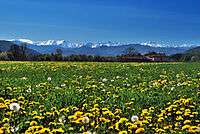

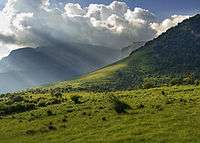
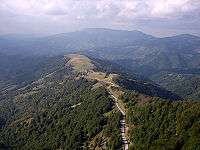
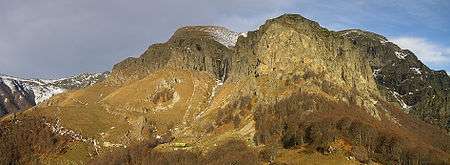
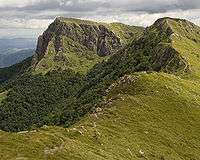
Geologically, the Balkan Mountains are a "young" part of the Alp-Himalayan chain that stretches across most of Europe and Asia. It can be divided into two parts: the main Balkan Chain and the Pre-Balkans to the north, which intrude slightly into the Danubian Plain. To the south, the mountain borders with the Sub-Balkan valleys - a row of 11 valleys running from the border with Serbia to the west to the Black Sea to the east which separate the Balkan mountains from a chain of other mountains known as Srednogorie which include Vitosha and Sredna Gora.
The range consists of around 30 portions called mountains. The Balkan Mountains can be divided into three sections:
- The Western Balkan Mountains from Vrashka Chuka at the border with Serbia to the Pass of Arabakonak with a total length of 190 kilometres (120 mi) and highest peak Midžor at 2,169 metres (7,116 ft).
- The Central Balkan Mountains from Arabakonak to the Vratnik Pass with a length of 207 kilometres (129 mi) and highest peak Botev Peak at 2,376 metres (7,795 ft), which is the highest in the range is located in that section.
- The Eastern Balkan Mountains from the Vratnik Pass to Cape Emine with a length of 160 kilometres (99 mi) and highest peak Balgarka at 1,181 metres (3,875 ft). The eastern Balkan Mountains forms the lowest part of the range.
The Balkan Mountains form a water divide between the rivers flowing to the Danube in the north and those flowing to the Aegean Sea in the south. However, they are crossed by Bulgaria's widest river, the Iskar, which forms the spectacular Iskar Gorge. Rivers that take their source from the Balkan Mountains and flow northwards to the Danube include the Timok, Archar, Lom, Tsibritsa, Ogosta, Skat, Vit, Osam, Yantra, and Rusenski Lom. The mountains are also the source of the Kamchiya, which flows directly into the Black Sea. Although not so abundant in mineral waters as other parts of Bulgaria, there are several spas such as Varshets, Shipkovo and Voneshta Voda. There are a number of waterfalls, especially in the western and central parts of the range, such as Raysko Praskalo which is the highest waterfall in the Balkan Peninsula, Borov Kamak, Babsko Praskalo, Etropole Waterfall, Karlovsko Praskalo, Skaklya and others.
Passes
The mountains are crossed by 20 passes and two gorges. There are paved roads crossing the Balkan Mountains at the following passes (listed from west to east):
- Petrohan Pass: Sofia - Montana
- Iskar Gorge (Iskarski prolom): Sofia - Vratsa (also railroad)
- Vitinya Pass: Hemus motorway (A2), Sofia - Botevgrad
- Beklemeto Pass: Troyan - Sopot
- Shipka Pass: Gabrovo - Kazanlak (also railroad)
- Pass of the Republic (Prohod na republikata): Veliko Tarnovo - Gurkovo
- Vratnik Pass: Elena - Sliven
- Kotel Pass (Kotlenski prohod): Kotel - Petolachka (Pentagram) crossroads
- Varbitsa Pass (Varbishki prohod): Shumen - Petolachka crossroads
- Rish Pass (Rishki prohod): Shumen - Karnobat
- Luda Kamchiya Gorge (Ludokamchiyski prolom): Provadiya - Karnobat (also railroad)
- Aytos Pass (Aytoski prohod) - Provadiya - Aytos
- Dyulino Pass (Dyulinski prohod): Varna - Aytos
- Obzor Pass (Obzorski prohod): Varna - Burgas, future Cherno More motorway (A3)
Peaks
- Botev Peak 2,376 m (7,795 ft), named after Hristo Botev.
- Vezhen Peak 2,198 m (7,211 ft)
- Midžor 2,169 m (7,116 ft), the highest peak in Serbia outside of Kosovo and north-western Bulgaria, 12th in the Balkan Mountains.
- Kom Peak 2,016 m (6,614 ft)
- Todorini Kukli 1,785 m (5,856 ft)
- Murgash 1,687 m (5,535 ft)
- Shipka Peak 1,523 m (4,997 ft)
- Buzludzha 1,441 m (4,728 ft)
- Balgarka Peak 1,181 m (3,875 ft)
- Levski Peak (named after Vasil Levski)
- Vetren 1,330 m (4,364 ft)
History
The Balkan Mountains have had a significant and special place in the history of Bulgaria since its foundation in 681. It was a natural fortress of the Bulgarian Empire for centuries and formed an effective barrier to Moesia where most of the medieval capitals were located. The Balkan mountains were the site of numerous battles between the Bulgarian and the Byzantine Empires including the Battle of the Rishki Pass (759), Battle of the Varbitsa Pass (811), Battle of Tryavna (1190) and many others. In the battle of the Varbitsa Pass, Khan Krum decisively defeated an enormous Byzantine army, killing Emperor Nikephoros I. For many centuries the Byzantines feared these mountains, and on several occasions Byzantine armies pulled back only on the news of approaching the Balkan Mountains.
During the Ottoman rule, many haiduks found refuge in the Balkan Mountains. Close to the highest summit, Botev Peak, is Kalofer, the birthplace of Hristo Botev, a Bulgarian poet and national hero who died in the western Balkan Mountains near Vratsa in 1876 in the struggle against the Ottoman Empire. Also close to Botev Peak is the Shipka Pass, the scene of the four battles in the Russo-Turkish War, 1877-78, which ended Turkish rule in the Balkans. Close to the pass in the village of Shipka, there is a Russian Orthodox church built to commemorate Russian and Bulgarian bravery during pass defense.
See also
- Balkans
- Bulgarka Nature Park
- Kom–Emine, a high-mountain long-distance trail along the main ridge of the Balkan Mountains
- Rhodope Mountains, Rila, Pirin, Dinaric Alps, Šar mountain, Pindus, Strandzha — other major mountain chains in the Balkan region
References and notes
- 1 2 "Bulgaria". google.com.
- ↑ Андрейчин Л. и др., Български тълковен речник (допълнен и преработен от Д. Попов). Четвърто преработено и допълнено издание.: Издателство “Наука и изкуство”. С., 1994
- ↑ Todorova, Maria N. (1997). Imagining the Balkans. New York: Oxford University Press, Inc. p. 27.
- ↑ "Balkhan Mountains". World Land Features Database. Land.WorldCityDB.com. Archived from the original on 28 February 2008. Retrieved 31 March 2008.
- ↑ "Balkan". Encarta World English Dictionary. Microsoft Corporation. Archived from the original on 31 October 2009. Retrieved 31 March 2008.
- ↑ "balkan". Büyük Türkçe Sözlük (in Turkish). Türk Dil Kurumu.
Sarp ve ormanlık sıradağ
- ↑ "Balkan studies". google.bg.
- ↑ "Gods and Heroes of the Greeks". google.bg.
- ↑ "SummitPost - Stara Planina (Balkana) -- Climbing, Hiking & Mountaineering". www.summitpost.org. Archived from the original on 6 October 2008. Retrieved 2008-10-14.
External links
| Wikivoyage has a travel guide for Balkan Mountains. |
| Wikimedia Commons has media related to Stara planina (Balkan Mountains). |
- Regional tourist association
- Euroregion Stara Planina
- Hiking in Balkan Mountains
- Controversy regarding ski resort development in ostensibly protected areas. (World Birdwatch, March 2009)
- Tourist portal Stara Planina

.svg.png)